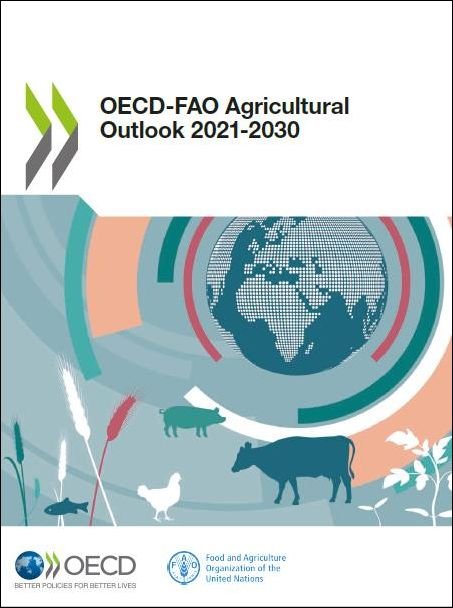 Read this article in French
Read this article in French- Share this article
- Subscribe to our newsletter
OECD-FAO Agricultural Outlook
Governments need to step up their efforts to meet global food security and environmental targets, according to the OECD-FAO Agricultural Outlook 2021-2030 released early July 2021 by the Food and Agricultural Organization of the United Nations (FAO) and the Organisation for Economic Co-operation and Development (OECD).
The report provides policy-makers with a consensus assessment of the ten-year prospects for 40 main farm and fisheries products at regional, national and global levels, analysing the drivers of performance in the agri-food markets and helping to inform forward-looking policy analysis and planning. The Outlook baseline projections describe expected trends based on existing policies, highlighting areas where additional effort is needed to meet the SDGs.
Global demand for agricultural commodities - including for use as food, feed, fuel and industrial inputs - is projected to grow at 1.2 per cent per year over the coming decade, albeit at a slower annual rate than during the previous decade. Demographic trends, the substitution of poultry for red meat in rich and many middle-income nations, and a boom in per capita dairy consumption in South Asia are expected to shape future demand.
Productivity improvements key to feeding a growing global population
Of the increases in global crop production expected in 2030, 87 per cent are projected to come from yield growth, while 6 per cent to come from expanded land use and 7 per cent from increases in cropping intensity. Similarly, a large share of the projected expansion in livestock and fish production is expected to result from productivity gains. However, herd enlargement is also expected to significantly contribute to livestock production growth in emerging economies and low-income countries.
Looking ahead to 2030, imports are projected to account for 64 per cent of total domestic consumption in the Near East and North Africa region, while Latin America and the Caribbean region is expected to export more than a third of its total agricultural production.
Global greenhouse-gas emissions from agriculture are projected to increase by 4 per cent over the next ten years, mostly due to expanding livestock production. This is despite the fact that emissions per unit of output - carbon intensity of production - are expected to decrease significantly over the period.
Food availability projected to increase
Globally, aggregate food availability is projected to grow by 4 per cent over the next decade, while per capita consumption of fats is projected to grow the fastest among major food groups.
In high-income countries, per capita food availability is not foreseen to expand significantly from its already high levels. However, there may be a shift away from staples and sweeteners to higher-value foods, including fruits and vegetables and, to a lesser extent, animal products.
In low-income countries, food availability is projected to increase by 3.7 per cent, equal to 89 calories per person per day, mainly consisting of staples and sweeteners. Economic constraints will limit increasing consumption of animal products, fruits and vegetables. Due to income constraints, the per capita consumption of animal protein is projected to decline slightly in Sub-Saharan Africa, a region whose self-sufficiency for major food commodities is, on current trends, expected to decrease by 2030.
While the FAO Food Price Index has risen strongly in the past year, these increases are expected to be followed by a period of downward adjustment. The Outlook projects that food prices will resume a gradually declining trajectory in real terms, consistent with slowing demand growth and expected productivity gains.
While the Outlook focuses on medium-term trends, a wide range of factors can generate the conditions for short-term price fluctuations in agricultural markets.
(FAO/OECD/ile)
Read more and download the OECD-FAO Agricultural Outlook 2021-2030 at FAO website





Add a comment
Be the First to Comment